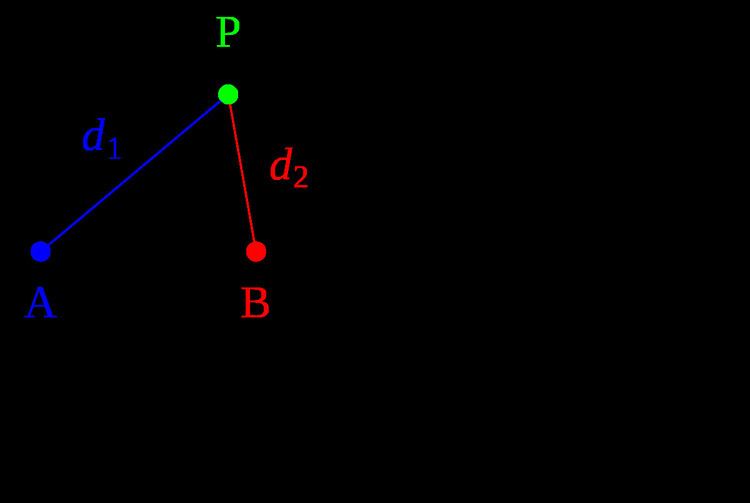 | ||
The circle of Apollonius is any of several types of circles associated with Apollonius of Perga, a renowned Greek geometer. Most of these circles are found in planar Euclidean geometry, but analogs have been defined on other surfaces; for example, counterparts on the surface of a sphere can be defined through stereographic projection.
Contents
- Apollonius definition of a circle
- Apollonius pursuit problem
- Circles sharing a radical axis
- Solutions to Apollonius problem
- Apollonian gasket
- Isodynamic points of a triangle
- References
The main uses of this term are fivefold:
Apollonius' definition of a circle
A circle is usually defined as the set of points P at a given distance r (the circle's radius) from a given point (the circle's center). However, there are other, equivalent definitions of a circle. Apollonius discovered that a circle could also be defined as the set of points P that have a given ratio of distances k = d1/d2 to two given points (labeled A and B in Figure 1). These two points are sometimes called the foci.
Apollonius pursuit problem
The Apollonius pursuit problem is one of finding where a ship leaving from one point A at speed v1 will intercept another ship leaving a different point B at speed v2. By assumption, the ships travel in straight lines and the ratio of their speeds is denoted as k = v1/v2. At the point they meet, the first ship will have traveled a k-fold longer distance than the second ship. Therefore, the point must lie on a circle as defined by Apollonius, with their starting points as the foci.
Circles sharing a radical axis
The circles defined by the Apollonian pursuit problem for the same two points A and B, but with varying ratios of the two speeds, are disjoint from each other and form a continuous family that cover the entire plane; this family of circles is known as a hyperbolic pencil. Another family of circles, the circles that pass through both A and B, are also called a pencil, or more specifically an elliptic pencil. These two pencils of Apollonian circles intersect each other at right angles and form the basis of the bipolar coordinate system. Within each pencil, any two circles have the same radical axis; the two radical axes of the two pencils are perpendicular, and the centers of the circles from one pencil lie on the radical axis of the other pencil.
Solutions to Apollonius' problem
In Euclidean plane geometry, Apollonius's problem is to construct circles that are tangent to three given circles in a plane.
Three given circles generically have eight different circles that are tangent to them and each solution circle encloses or excludes the three given circles in a different way: in each solution, a different subset of the three circles is enclosed.
Apollonian gasket
By solving Apollonius' problem repeatedly to find the inscribed circle, the interstices between mutually tangential circles can be filled arbitrarily finely, forming an Apollonian gasket, also known as a Leibniz packing or an Apollonian packing. This gasket is a fractal, being self-similar and having a dimension d that is not known exactly but is roughly 1.3, which is higher than that of a regular (or rectifiable) curve (d = 1) but less than that of a plane (d = 2). The Apollonian gasket was first described by Gottfried Leibniz in the 17th century, and is a curved precursor of the 20th-century Sierpiński triangle. The Apollonian gasket also has deep connections to other fields of mathematics; for example, it is the limit set of Kleinian groups.
Isodynamic points of a triangle
Circles of Apollonius may be used as a technical term to denote three special circles
All three circles intersect the circumcircle of the triangle orthogonally. All three circles pass through two points, denoted as the isodynamic points
The centers of these three circles fall on a single line (the Lemoine line). This line is perpendicular to the radical axis defined by the isodynamic points
